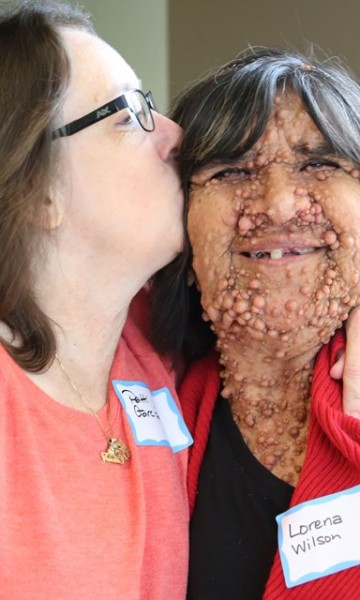Selumetinib Research Question
The following is a blog by Dr. Luiz Rodrigues. Originally posted in Portuguese on January 13, 2017. Additions and translation were provided by Dr. Mata-Machado from the NF Clinic at Amita Health/St. Alexius.
Question: Can you tell me more about the drug Selumetinib and when it might be regularly available for treatment of plexiform tumors in neurofibromatosis?
Thank you for your question, which I consider very important. To answer, I need to cover some areas.
Part 1 – Differences between neurofibromas
To begin with, I would like to remind you that the SELUMETINIB study that gave us hope needs to be repeated by another group of independent scientists from the pharmaceutical industry producing the medicine, so that we can be sure the drug brings more benefits than harm to people.
In addition, upcoming drug trials need to determine whether SELUMETINIB works the same way for different types of plexiform neurofibromas. Does it work only when neurofibromas are growing and does it work the same at any age in people with plexiform neurofibromas? The behavior of plexiform neurofibromas varies greatly in people with neurofibromatosis type 1 as to the type, growth rate and age of people, as shown in a very successful study in Germany in 2012 by the team of Dr. Victor Mautner (See full article HERE ). The plexiforms may be diffuse, or nodular, or mixed, and the same person may present one or more of each of these types. The different types have varying growth and complications and the same person may present with a growing plexiform and another that remains the same size (or even reduces, see below). However, in the study in question, by means of three-dimensional full-body magnetic resonance imaging, Dr. Mautner’s team examined all plexiforms together, without separating into diffuse or nodular or mixed.
Part 2 – Results of studies in Germany.
According to the study by Dr. Mautner’s group, about half of 201 people with NF1 in the study had plexiform neurofibromas, 40% of which were internal, ie. visible in imaging studies, and 30% superficial, or visible on the clinical examination. The plexiforms are usually congenital, that is, they are already present at birth. In the study, those people who did not have plexiforms at the start of the study, did not present new tumors. Those other people who already had plexiforms developed new tumors throughout the study, at an average of 1 new tumor every two years. This result suggests that whoever does not present a plexiform late in childhood will probably never develop this tumor throughout their lives and this is important information for families. The researchers also found that the plexiform can be small or large in volume: the average size found was 86 milliliters (that is, about four tablespoons), ranging from the lowest with 5 milliliters to the largest with almost 6 liters. The mean growth rate of plexiforms was 3.7% per year and was influenced by tumor volume: the higher the initial volume, the higher the growth rate, which varied from -13.4% to + 111% per year. One surprising finding, at least for me, was the decrease of 3 to 4% of plexiform volume per year in about 35% of adults, without any type of medication or surgery. Although the authors have raised the possibility of measurement error, this spontaneous reduction (or measurement error) needs to be taken into account in drug-testing studies, such as SELUMETINIB. The growth rate of plexiforms also varied according to age, being higher in childhood than after age 18. The same group of scientists had already observed up to 20% increase in volume per year in younger children (see HERE for summary of article). For example, a 5-year-old child with a plexiform volume of 200 ml (a common beaker) may present the tumor with about 240 ml a year later. At around 25 years the rate of increase of plexiforms is already much smaller, only about 0.5% (half percent) per year. That is, a 25-year-old adult with a 200-ml tumor would have a 201-ml tumor the next year, that is, a change barely perceptible to the naked eye.
Part 3 – Effects of surgery on plexiforms.
In another scientific study published the following year (2013), the same group of Dr. Mautner presented new information on the behavior of plexiforms after surgical treatment (see HERE). These results are fundamental for comparing the effects of surgery with SELUMETINIB or other drugs. The researchers studied 52 people with NF1, with a mean age of 25 years, who underwent surgery for treatment of plexiform neurofibromas due to pain (20), or aesthetic deformity (21), or neurological deficits (16) or for these combined causes. The main results of the surgery were: complete resolution of the symptoms in 46% of the people, partial resolution in 10% and unaltered result in 31% of the operated cases. Tumors returned (or continued) to grow in 23% of people after surgery, and the analysis showed that surgery did not interfere with the growth rate of plexiforms. On the other hand, the undesirable effects of surgery were acute complications, such as bleeding, in 10% and healing difficulties in 5%. Some patients (13%) developed new complaints after surgery. The best result observed with the surgery was when the doctors were able to remove the plexiform completely (to the naked eye) and this happened in 25% of the cases, And these tumors did not grow again until the end of follow-up (about 3 years). However, these tumors that could be completely resected were the smallest and more superficial tumors and in people above the age of 18 years. In conclusion, the two studies have suggested that children with larger plexiform tumors have the highest growth rate of tumors and that plexiform surgery has its worst results in the larger and more complex tumors (neck and head) in this population. Thus, new drug studies (such as SELUMETINIB) should focus on this population in which surgery presents its worst results. In other words, they need to clarify whether the drug should only be used in children or adults. Besides that, should be used only in the tumors that are growing or in all of them?
Part 4 – So what would be the duration of the new research phases with SELUMETINIB?
I am not able to answer precisely about this drug, SELUMETINIB, because I do not know the details of the research project yet. In general, however, if the goal of further studies is to reduce the initial tumor size by at least 20%, a sufficiently large study time will be required and similar to the original study for this effect to be observed, which was a year and a half of the use of SELUMETINIB. Another problem in determining the duration of any study with drugs is that it can be interrupted when one realizes that one already has the answers before the term, either for good (positive effects on health) or for bad (toxic effects or worsening of health). Therefore, in general, I imagine that the duration of each of these next phases of the research with SELUMETINIB will be around 2 years, so that it is defined as an adequate drug or not for the treatment of plexiforms. This, in the field of scientific research. If the drug proves effective, it should be submitted to health surveillance agencies which may take a longer time than I can safely define.







.png)






I’m 58 and it seems like the older I get the more rapid they grow. NF1 has made my life a living hell. I’ve had multiple removed inside and out. The latest is my Whipple Surgery I had in 2016 and in 2018 they told me they see signs of MS. I can’t win☹️😢. I would love to see something that can slow this condition or maybe even get rid of it.
I’m clinical geneticits . I have a patient six years old with NFB1 and neurofibromas . How I can obtain information for treatment in a compassive form with selumetinib?
Maria, you should probably contact a doctor that specializes in NF and involved in clinical trials to learn more about the compassionate use of selumetinib. Please email us at or call 630-945-3562 and we can give you some suggestions.